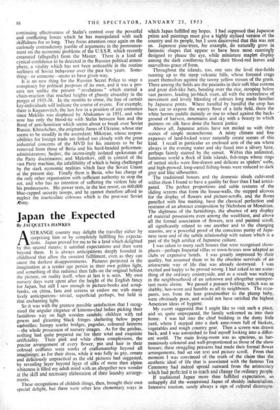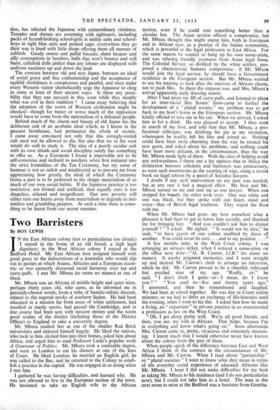Japan the ,Expected
By JACQUETTA HAWKES ASTRANGE country may delight the traveller either by surprising him or by completely fulfilling his expecta- tions. Japan proved for me to be a land which delighted by this second means; it satisfied expectations and then went beyond them. It is always anticipations deeply founded in childhood that allow the sweetest fulfilment, even as they can cause the darkest disappointments. Pictures projected in the imagination at a tender age persist in their own golden light, and something of this radiance then falls on the original behind the picture, on reality itself, when at last it is seen. My own nursery days were spent after the height of the English fancy for Japan, but still I saw enough in picture-books and scrap- books, on china, fans and screens to endow me with many lively anticipations—trivial, superficial perhaps, but held in that enchanting light. So it was with the greatest possible satisfaction that I recqg- nised the angular elegance of kimono-clad ladies picking their fastidious way on high wooden sandals; children with red gowns and gleaming -black fringes sheltering below paper umbrellas; humpy scarlet bridges, pagodas, coloured lanterns —the whole procession of nursery images. As for the geishas, nothing had quite prepared me- for tbeir total and exquisite artificiality. Their pink and white china complexions, the precise arrangement of every flower, pin and hair in their colossal coiffures were works of craftsmanship beyond all imaginings; as for their dress, while it was fully as gay, ornate and deliciously unpractical as the old pictures had suggested, by revealing layer beyond layer of silks of more than alpine whiteness it filled my adult mind with an altogether new wonder at the skill and necessary elaboration of their laundry arrange- ments.
These recognitions of childish things, then, brought their own special delight, but there were other less elementary ,ways in
'
which Japan fulfilled my hopes. I had supposed that Japanese prints and paintings must give a highly stylised version of the country and its people, but I soon discovered that this was not so. Japanese pine-frees, for example, do naturally grow in fantastic shapes that appear to have been most cunningly designed to please the eye, while miniature maples- display among the dark coniferous foliage their blood-red leaves and marvellous grace of form.
Throughout the islands, too, one sees the level rice-fields running up to the steep volcanic hills, whose forested crags assert themselves against the tawny yellow tresses of the grain. There amongthe fields are the peasants in their soft blue cottons and great dish-like hats, bending over the rice, stooping below vast paniers, leading jet-black oxen, all with the correctness of movement and lovely blending of colours long made familiar by Japanese prints. Where handful by handful the crop has been cut to expose the watery floor of a little field, there the white herons paddle daintily or rise to wheel against the back- ground of harvest, mountains and sky with a beauty to which painters on silk have done the barest justice.
Above all, Japanese artists have not misled us with their scenes of simple monochrome. A misty climate and fine expanses of land-locked water naturally create scenes of this kind. I recall in particular an enclosed arm of the sea where always in the evening water and sky fused into a silvery haze, perhaps faintly stained by the sunset. Within this unlimited, luminous world a flock of little islands, fish-traps whose rings of netted sticks were fine-drawn and delicate as spiders' webs, and high-prowed, long-oared fishing-boats were reduced to dark grey and lilac silhouettes.
The traditional houses and the domestic ideals cultivated within them I found to have a quality far finer than I had antici- pated. The perfect proportions and suble textures of the sliding screens that form the house-walls, the stepped alcoves for the display of flowers and picture-scrolls, and the floors panelled with fine matting, have the classical perfection and restraint of an abstract composition by Nicholson or Mondrian. The slightness of the furnishings, the absence of any display of material possessions even among the wealthiest, and above all the formal association of flowers, text and painted scroll, all significantly related to one another and to the changing seasons, are a powerful proof of the conscious purity of Japa- nese taste and of the subtle relationship with nature which is a part of the high artifice of Japanese culture.
I was taken to many such houses that were recognised show- places—perhaps Imperial villas or town-hcuses now adapted as clubs or expensive hotels. I was greatly impressed by their quality, but assumed them to be the obsolete -survivals of an aristocratic way of life that was already destroyed. I was excited and happy to be proved wrong. I had asked to see some- thing of the ordinary countryside, and as a result was walking in the neighbourhood of an unknown and altogether unimpor- tant rustic shrine. We passed a peasant holding, which was as shabby, hen-worn and humble as all its neighbours. The occu- pants, too, from the lean grandmother to the plump baby, were obviously poor, and would not have satisfied the highest American ideas of hygiene.
My escort suggested that I might like to visit such a place, and so, quite unprepared-, the family welcomed us into their home. I was led into the chief building in the dusty little yard, where I stepped into a dark ante-room full of baskets, vegetables and rough country gear. Then a screen was drawn back, and I was astonished to find myself looking into a differ- ent world. The main living-room was as spacious, as har- moniously coloured and well-proportioned as those of the show houses; these struggling peasants had made their formal flower arrangements, had set out text and picture scroll. From that moment I was convinced of the truth of the claim that the aesthetic ideal of life that is associated with the famous Tea Ceremony had indeed spread outward from the aristocracy which had perfezted it to reach and change the ordinary people. If traditional Japan more than fulfilled expectation, so unhappily did the- westernised Japan of shoddy industrialism. Intensive tourism, surely always a sign of cuhural disinteera- tion, has infected the Japanese with extraordinary virulence. Temples and shrines are swarming with sightseers, including packs of fecundtlooking school-girls in middy suits and school.- boys in tight blue suits and peaked caps; everywhere they go their way is lined with little shops offering them all manner of rubbish. Gaudy sweets and pallid biscuits, sham lacquer and silly contraptions in bamboo, balls that won't bounce and will burst, celluloid dolls pinker than any lobster are displayed with uniform nastiness up and down the land.
The contrast between old and new Japan, between an ideal of social grace and fine craftsmanship and the acceptance of squIlid shoddiness is conspicuous and painful, and must make every Western visitor shamefacedly urge the Japanese to cling to some at least of their ancient ways. Is there any possi- bility that they can succeed in this, even 'while they modify what was evil in their tradition ? I came away believing that the adoption of the worst of Western civilisation might be checked—though for better or worse much of the opposition would have to come from the nationalism of a defeated people. Behind much of the charm and beauty of old Japan lies the deliberate cult of an aesthetic ideal which, as I learnt in the 'peasant farmhouse, had permeated the whole of society. I came away convinced not only that this strongly-rooted cult need not be alloWed to die, but also that We in the west would do well to study it. The idea of a purely secular cult with its own rituals and social discipline surely has something to offer us. As a European I found it impossible not to be self-conscious and inclined to mockery when first initiated into the strict formalities of the Tea Ceremony, but my sense of humour is not so oafish and misdirected as to prevent me from appreciating how greatly the ideal of which the Ceremony forms a part is to be preferred to the sloppy materialism of so much of our own social habits. If the Japanese practice is too restrictive, too formal and artificial, then equally ours is too shapeless, relaxed and insignificant. Our new poverty will either turn our hearts away from materialism or degrade us into aimless and grumblingyaupers. At such a time there is some- thing to be learnt from our recent enemies.



































 Previous page
Previous page